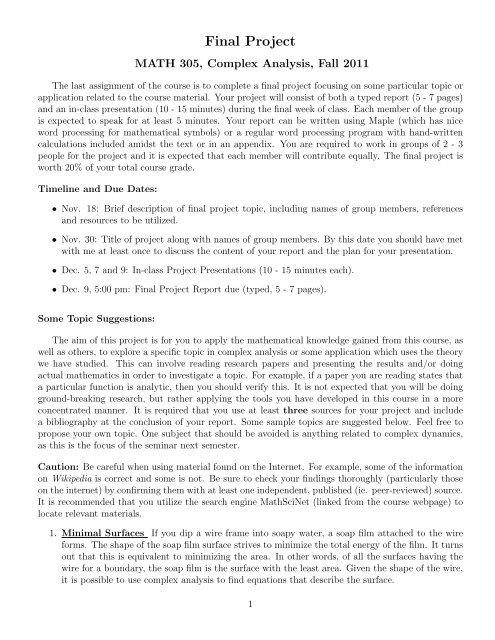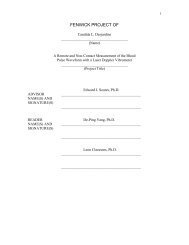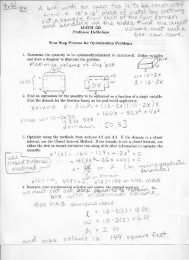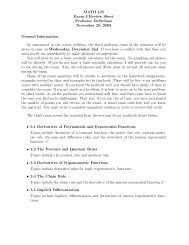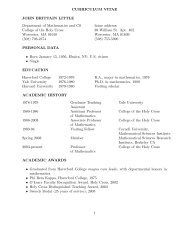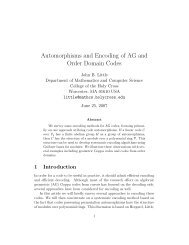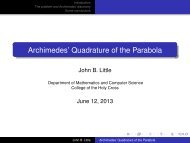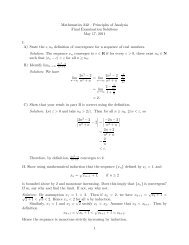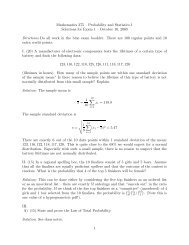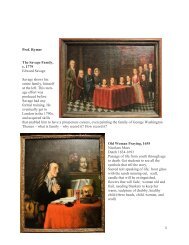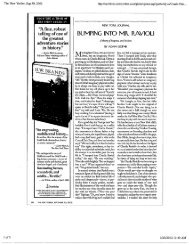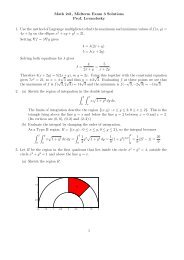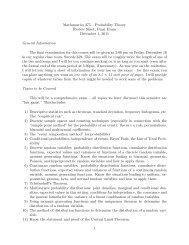Final Project - Mathematics and Computer Science
Final Project - Mathematics and Computer Science
Final Project - Mathematics and Computer Science
You also want an ePaper? Increase the reach of your titles
YUMPU automatically turns print PDFs into web optimized ePapers that Google loves.
<strong>Final</strong> <strong>Project</strong><br />
MATH 305, Complex Analysis, Fall 2011<br />
The last assignment of the course is to complete a final project focusing on some particular topic or<br />
application related to the course material. Your project will consist of both a typed report (5 - 7 pages)<br />
<strong>and</strong> an in-class presentation (10 - 15 minutes) during the final week of class. Each member of the group<br />
is expected to speak for at least 5 minutes. Your report can be written using Maple (which has nice<br />
word processing for mathematical symbols) or a regular word processing program with h<strong>and</strong>-written<br />
calculations included amidst the text or in an appendix. You are required to work in groups of 2 - 3<br />
people for the project <strong>and</strong> it is expected that each member will contribute equally. The final project is<br />
worth 20% of your total course grade.<br />
Timeline <strong>and</strong> Due Dates:<br />
• Nov. 18: Brief description of final project topic, including names of group members, references<br />
<strong>and</strong> resources to be utilized.<br />
• Nov. 30: Title of project along with names of group members. By this date you should have met<br />
with me at least once to discuss the content of your report <strong>and</strong> the plan for your presentation.<br />
• Dec. 5, 7 <strong>and</strong> 9: In-class <strong>Project</strong> Presentations (10 - 15 minutes each).<br />
• Dec. 9, 5:00 pm: <strong>Final</strong> <strong>Project</strong> Report due (typed, 5 - 7 pages).<br />
Some Topic Suggestions:<br />
The aim of this project is for you to apply the mathematical knowledge gained from this course, as<br />
well as others, to explore a specific topic in complex analysis or some application which uses the theory<br />
we have studied. This can involve reading research papers <strong>and</strong> presenting the results <strong>and</strong>/or doing<br />
actual mathematics in order to investigate a topic. For example, if a paper you are reading states that<br />
a particular function is analytic, then you should verify this. It is not expected that you will be doing<br />
ground-breaking research, but rather applying the tools you have developed in this course in a more<br />
concentrated manner. It is required that you use at least three sources for your project <strong>and</strong> include<br />
a bibliography at the conclusion of your report. Some sample topics are suggested below. Feel free to<br />
propose your own topic. One subject that should be avoided is anything related to complex dynamics,<br />
as this is the focus of the seminar next semester.<br />
Caution: Be careful when using material found on the Internet. For example, some of the information<br />
on Wikipedia is correct <strong>and</strong> some is not. Be sure to check your findings thoroughly (particularly those<br />
on the internet) by confirming them with at least one independent, published (ie. peer-reviewed) source.<br />
It is recommended that you utilize the search engine MathSciNet (linked from the course webpage) to<br />
locate relevant materials.<br />
1. Minimal Surfaces If you dip a wire frame into soapy water, a soap film attached to the wire<br />
forms. The shape of the soap film surface strives to minimize the total energy of the film. It turns<br />
out that this is equivalent to minimizing the area. In other words, of all the surfaces having the<br />
wire for a boundary, the soap film is the surface with the least area. Given the shape of the wire,<br />
it is possible to use complex analysis to find equations that describe the surface.<br />
1
Sample Resource: “Complex Variables,” second edition, Stephen Fisher, Dover Books (1990).<br />
See pp. 249–252 <strong>and</strong> 284–285.<br />
2. Fluid Flow The problem of describing how fluid flows around an obstacle has many practical<br />
applications, e.g., underst<strong>and</strong>ing how air flows around an airplane wing. Conformal mapping<br />
techniques allow us to transform problems with complicated obstacles into simpler ones, <strong>and</strong> find<br />
equations for the streamlines of the fluid flow. Maple computations <strong>and</strong> plots will be useful for<br />
this project.<br />
Sample Resource: “Complex Variables,” second edition, Stephen Fisher, Dover Books (1990).<br />
See pp. 261–284.<br />
3. Temperature Distributions<br />
Suppose that we know the the temperature on the outside of an object, <strong>and</strong> we want to predict<br />
the temperature on the inside. Imagine, for example, a building with one side facing south (warm)<br />
<strong>and</strong> the opposite side facing north (cold). Complex analysis gives a simple method for determining<br />
the temperature at any point inside the building. This relates to our discussion about harmonic<br />
functions <strong>and</strong> Laplace’s equation. The material in chapter 10 of the course text is a good resource<br />
for this project.<br />
4. The Riemann Zeta Function One of the most important functions in number theory is the<br />
Riemann zeta function, defined as<br />
ζ(s) =<br />
∞∑<br />
n=1<br />
1<br />
, where s ∈ C.<br />
ns This series converges absolutely for Re(s) > 1 <strong>and</strong> can then be analytically extended to all of C.<br />
One of the most famous unsolved problems in mathematics (worth one million dollars if you can<br />
solve it! – not to mention instant fame <strong>and</strong> glory) is the Riemann hypothesis, which conjectures<br />
that the non-trivial roots (zeroes) of ζ(s) all have real part equal to 1/2.<br />
5. Complex Variables <strong>and</strong> the N-Body Problem<br />
Complex variables <strong>and</strong> the theory of complex functions turns out to be particularly useful for<br />
underst<strong>and</strong>ing properties of solutions to the N-body problem. This problem studies the motion<br />
of heavenly bodies under Newtonian gravitation. It even turns out that Cauchy was guided by<br />
some of Kepler’s work on the two-body problem as he developed his theory of complex analytic<br />
functions.<br />
Good Resource: “A visit to the Newtonian N-body problem via elementary complex variables,”<br />
Don Saari, American Mathematical Monthly 97 (1990), no. 2, 105–119.<br />
6. Topics in Geometry<br />
Complex variables are often very useful for proving interesting facts from geometry. For example,<br />
if z 1 ,z 2 <strong>and</strong> z 3 are three points in the complex plane, <strong>and</strong> p(z) = (z − z 1 )(z − z 2 )(z − z 3 ), then<br />
2
the roots of p ′ (z) are the foci of the Steiner inellipse (the ellipse with largest area contained in the<br />
triangle formed by the three points).<br />
Sample Resource: “Triangles, ellipses, <strong>and</strong> cubic polynomials,” Minda, D. <strong>and</strong> Phelps, S.,<br />
American Mathematical Monthly 115 (2008), no. 8, 679–689.<br />
7. Complex Functions of Several Variables<br />
You’ve made the jump before, from one-variable calculus to multivariable calculus. Now try<br />
the same leap but with complex functions instead. Explain some of the important differences<br />
between the study of complex functions of one variable <strong>and</strong> the field of “several complex variables.”<br />
Illustrative examples would be useful.<br />
8. History of a Complex Analyst<br />
Investigate the life <strong>and</strong> work of a famous complex analyst such as Augustin Cauchy or Bernhard<br />
Riemann. For this kind of project, you should have at least five sources in your bibliography. You<br />
should also present some piece of mathematics by the analyst that was not covered in class.<br />
9. Topics from the Text<br />
You are welcome to explore topics in the textbook that we did not cover in class. There is plenty<br />
of interesting material in the last four chapters of the text. You should be sure to consult with me<br />
to identify a specific course of study. Your project might include working through some exercises<br />
in the textbook.<br />
3


